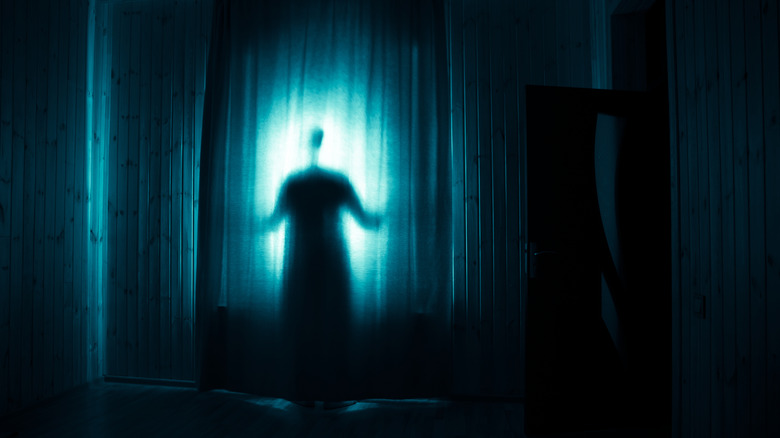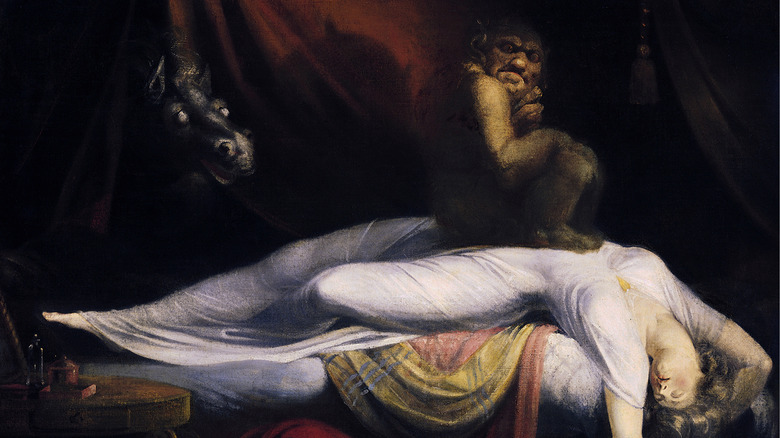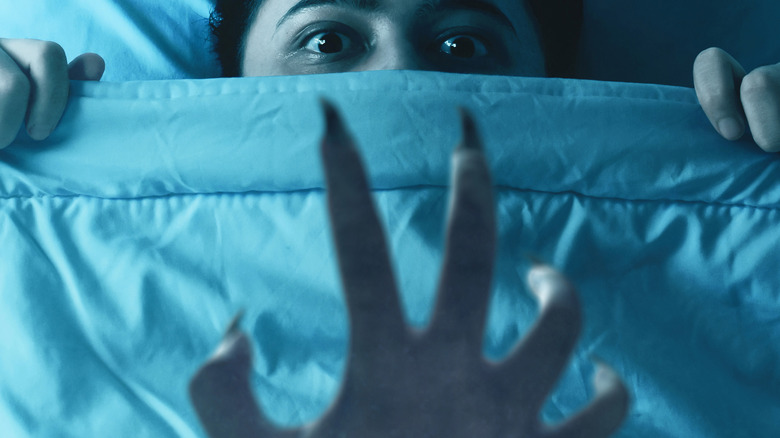Shadow People: The Urban Legend Explained
Many of us can likely remember a "monster under the bed" moment from childhood, some shadow in a corner that shifted, or a fear of the dark that sometimes still creeps up behind us in the late hours of night. It's natural for humans to fear darkness. After all, when else would our ancestors have been most vulnerable? Huddling around a fire, eyeing shapes in the forest, wondering if a predator would nab us and drag us away, waiting for a parental figure to say everything is ok.
Such fears form the crux of the "shadow people" urban legend. The central story is simple and may vary a bit from person to person but generally contains the same elements. It's late at night, you're lounging in bed on the verge of sleep, or wake up in the middle of the night, and there's a human-shaped, shadowy silhouette nearby. As Horror Made explains, some folks describe seeing glowing eyes or teeth. Sometimes these entities, apparitions, illusions — whatever's actually going on — appear right next to someone's bed and just stare down at them. Some people have described more shapeless shadow masses, and some have seen such shapes while walking around at night. Suddenly there's a sense of being watched, as all of us have doubtlessly felt, and then our attuned senses start scouring the environment for a threat.
But what's the truth behind these stories? Is it mere sensory confusion while trapped between wakefulness and sleep? Or is something actually there?
Succubae, incubi, and hat men
Stories of shadow people often come up in conversations about other disturbing urban legends, like black-eyed children who show up at your door and ask to come inside (per TBS News), or tales of "hat men," a kind of shadow man variation that looks like it's wearing an old-style FBI fedora (per The Week). In nearly all cases, people describe an intense, nigh-cosmic, terror and an inability to move.
The uncanny thing about these stories is that they've been documented across the world, in various countries and cultures. Granted, the internet makes it easier for people to be influenced by information, and we all know how easy it is for humans to fall prey to absurd beliefs (Pizzagate, anyone?). But while some shadow people cases are likely pleas for attention, is it actually possible that thousands of people are experiencing the same hallucination?
One clue can be found in a commonality shared across encounters, described on Quartz, "The fear sucked the breath from Brown's chest, rendering him mute and immobile." At this, clever readers might recall Henry Fuseli's well-known 18th-century painting of a little goblin sitting on a woman's chest while she sleeps (above), as Discover Magazine discusses. This painting, "The Nightmare," has been cited as a depiction of ancient stories of succubae (female demons) and incubi (male demons) who visit people in their sleep. And as it turns out, all such stories might be descriptions of what's called "sleep paralysis."
Sleep paralysis and hallucinations
Frontiers in Psychology published a paper in 2016 going into details about the relationship between sleep paralysis and tales like those of succubae and incubi. Basically, REM sleep — the stage of sleep where people dream — paralyzes the body. As Live Science explains, motor neurons "switch off" when dreaming, making it impossible for someone to flail around (aside from slight twitches and fluttering eyelids). Sleep paralysis occurs when the motor neurons get switched off in someone is actually conscious, which essentially transforms dreams into hallucinations. People are trapped in a weird, multisensory, half-asleep, half-awake state while still dreaming.
This could account not just for shadow people, but "Old Hag" legends in Canada, "pisadeira" in Brazil, "pasanta" in Catalonia, the phrase "a dead body climbed on top of me" in Mexico, the "khmaoch sângkât" ghost in Cambodia, the "pressing spirit" of Vietnam and Laos, the "phi am" of Thailand, "kanashibari" in Japan, stories of "ghost oppression" in China, and more. These all describe a horrific supernatural entity, often hazy black, crushing one's breath while in a half-asleep, half-awake state.
Science goes on to describe how stimulation in a certain region of the brain, the left temporoparietal junction (TPJ), can actually induce hallucinations of not just a chest-crushing entity, but shadowy humanoids, specifically. This same part of the brain is responsible for the aforementioned, universe feeling of "being followed" or watched. Looks like our nightmares might just be in our heads, after all.


